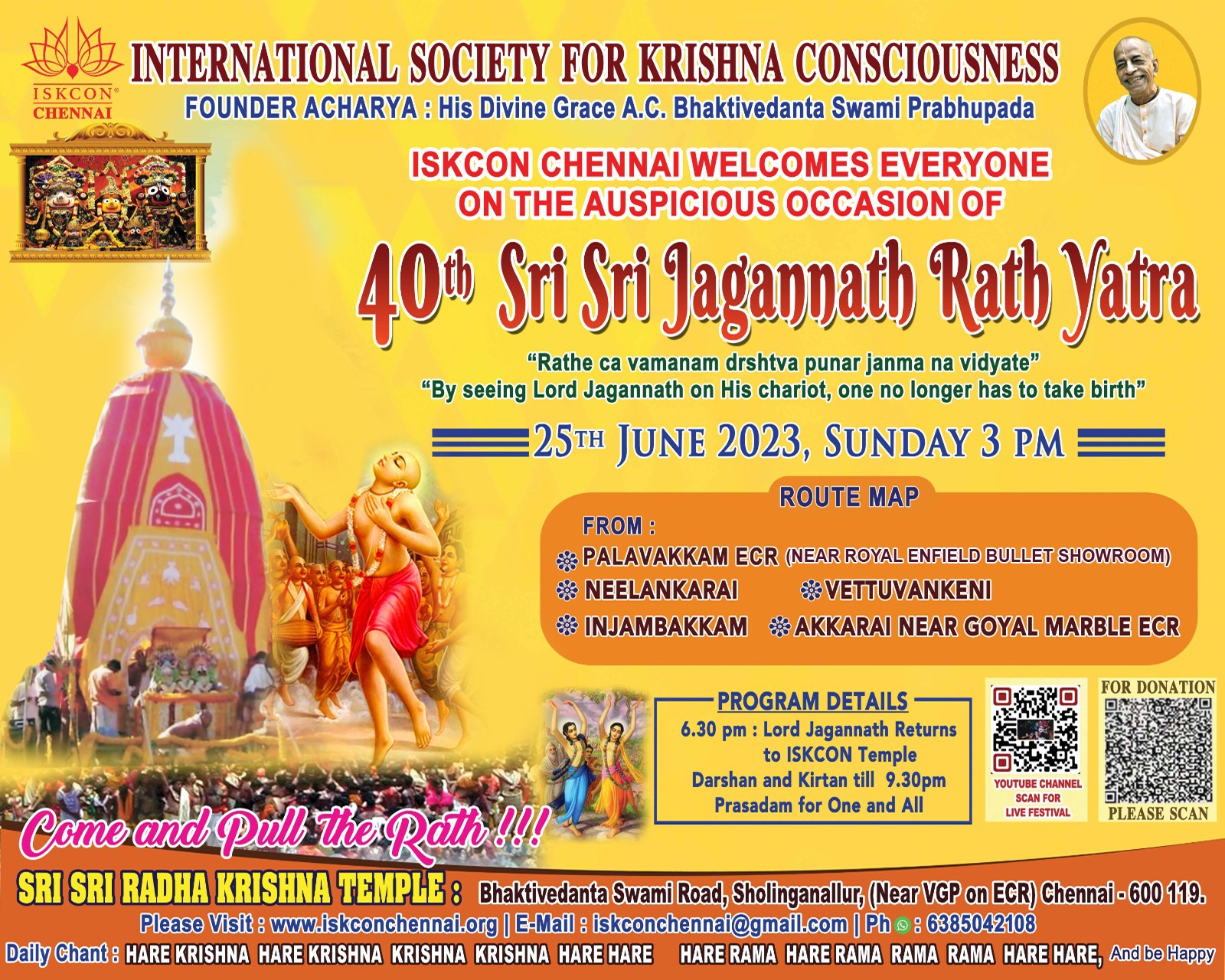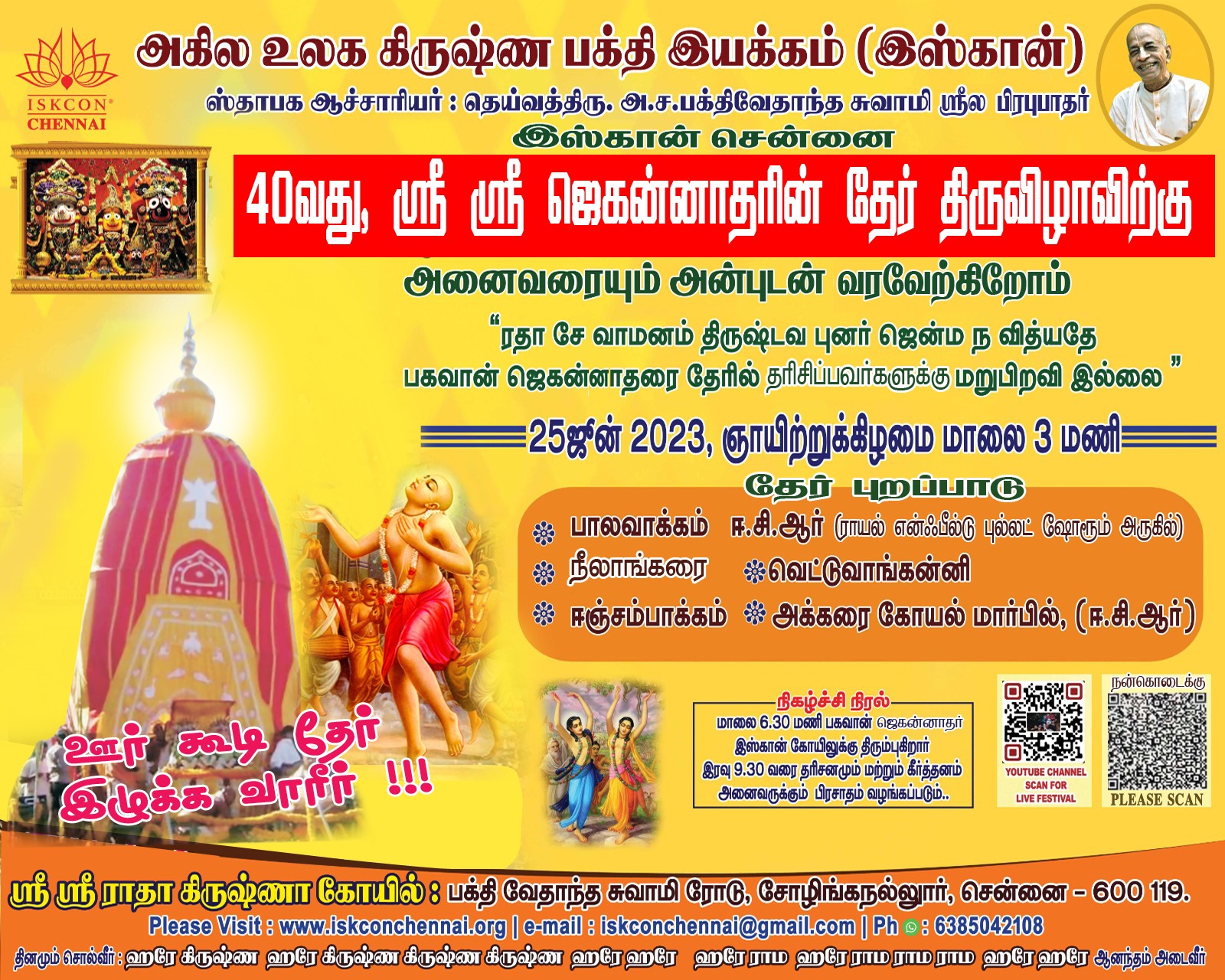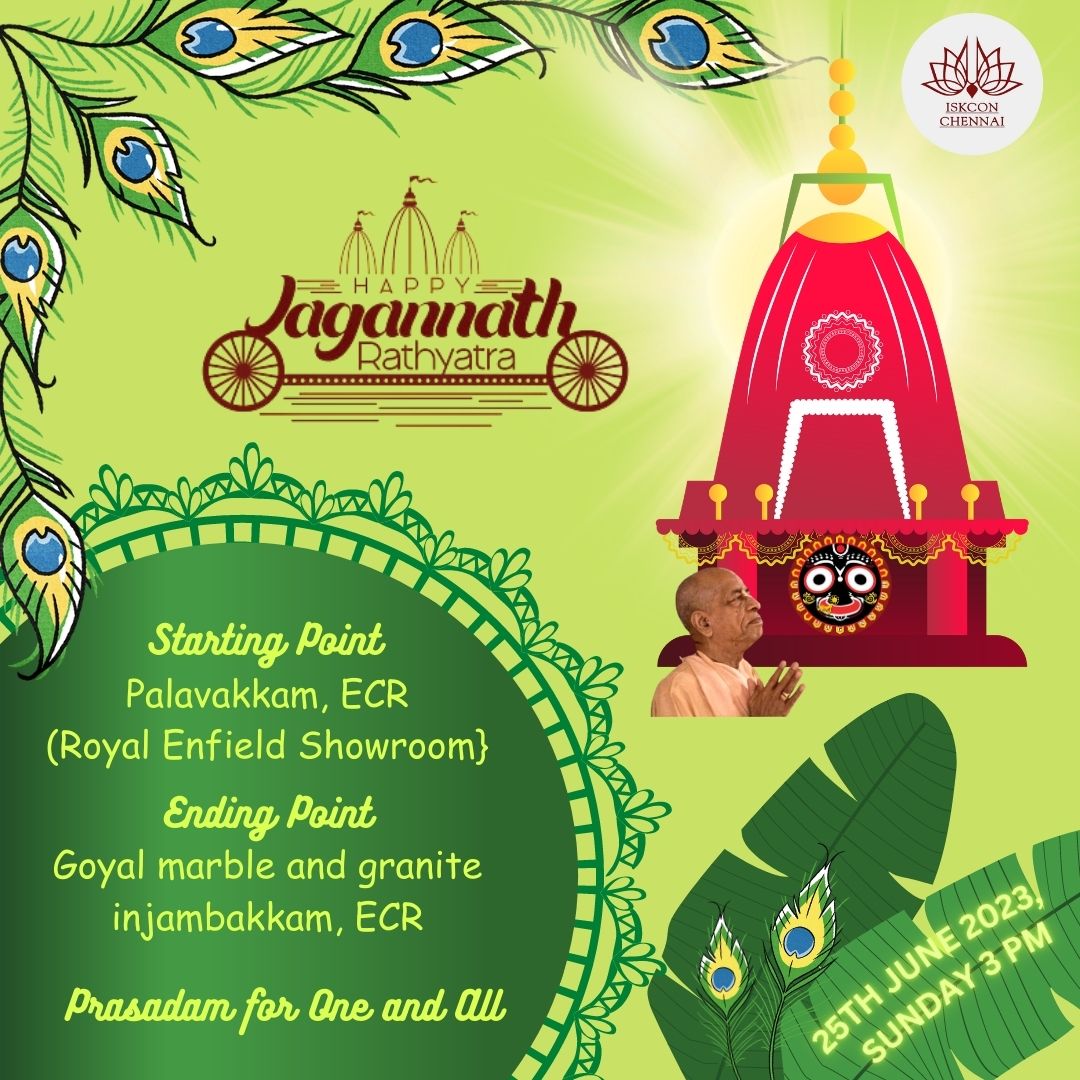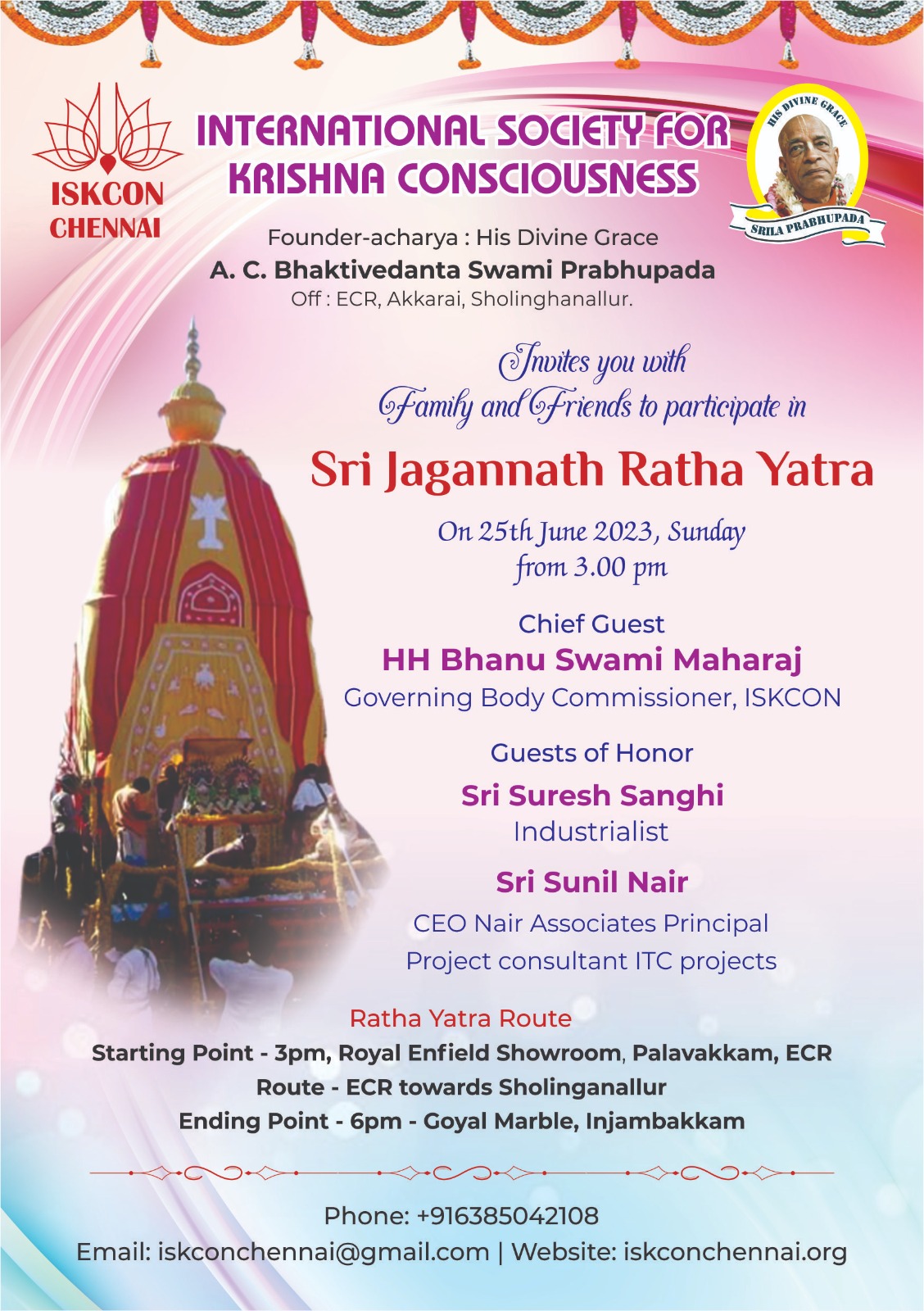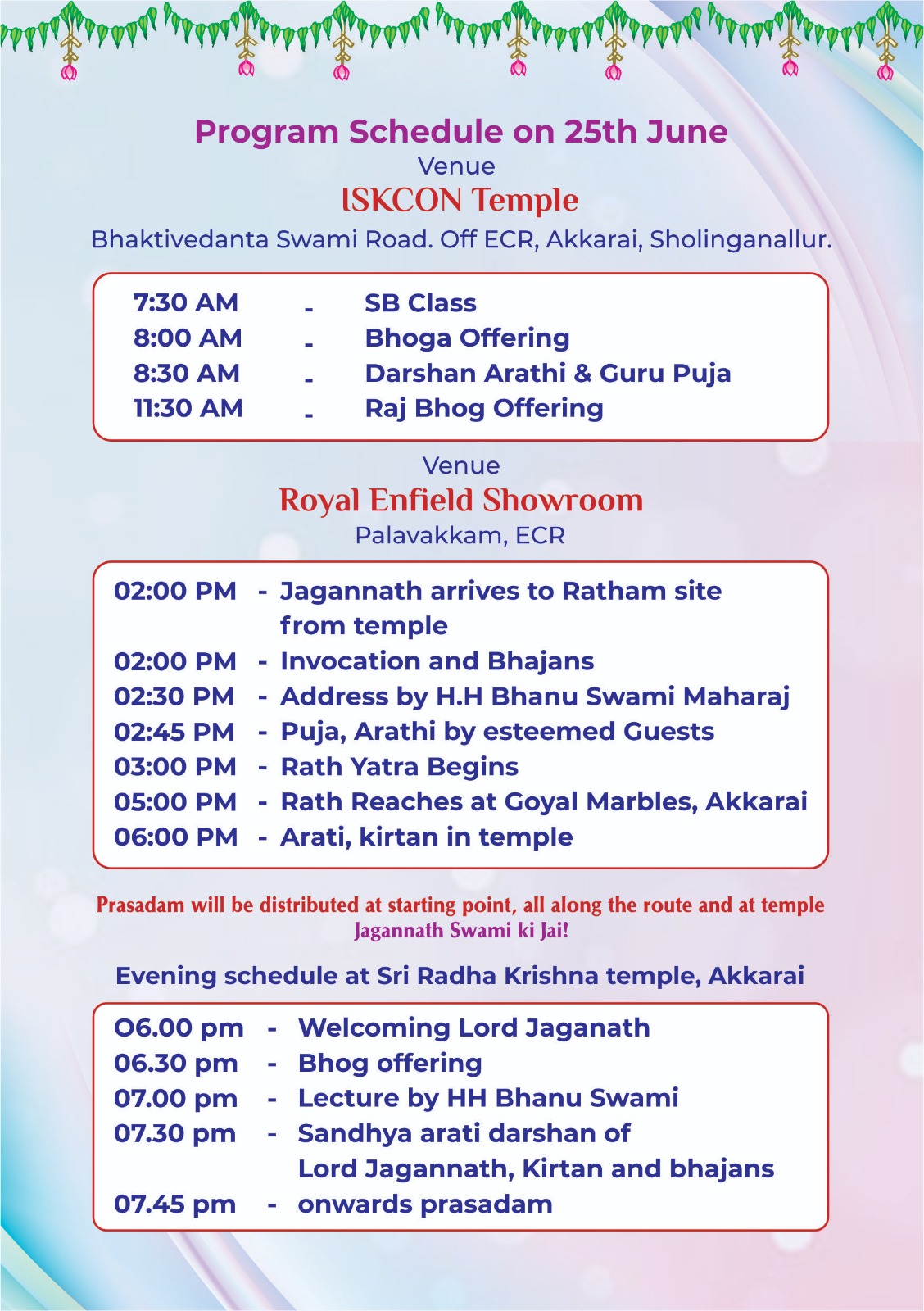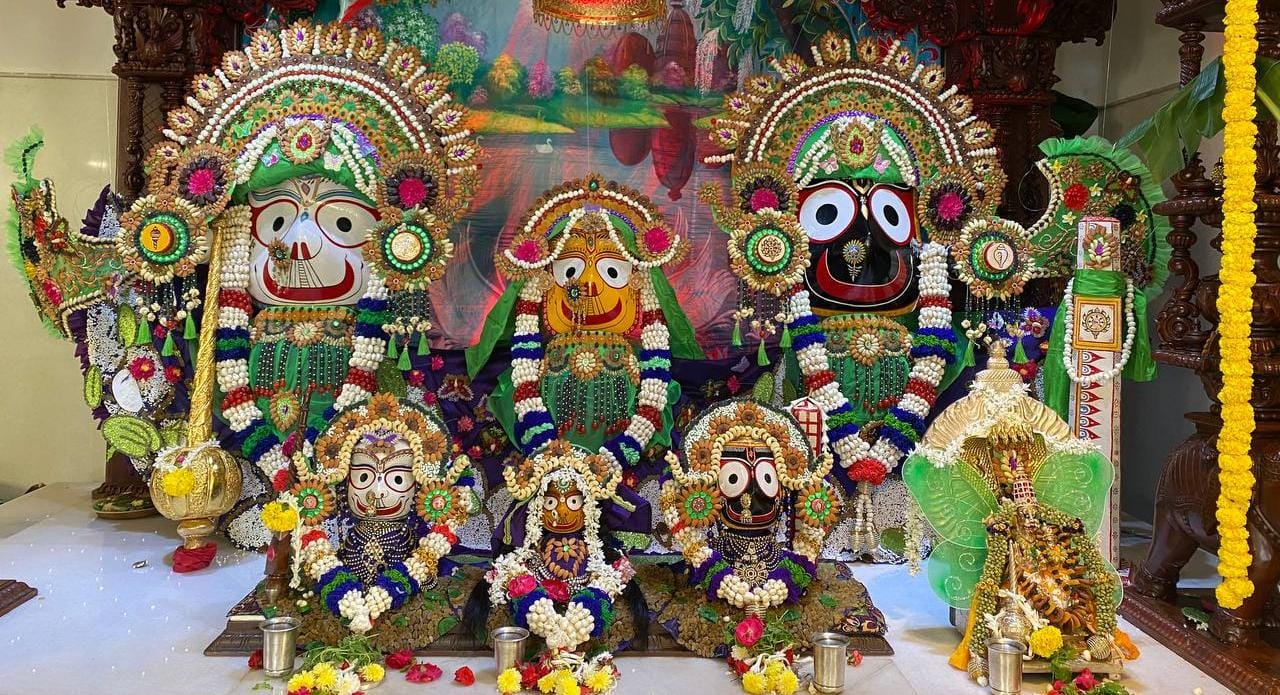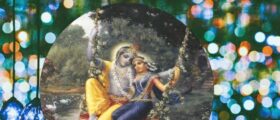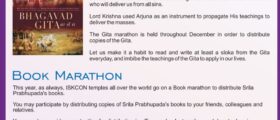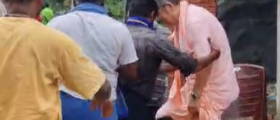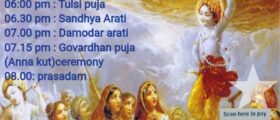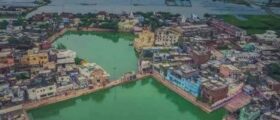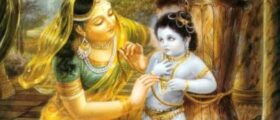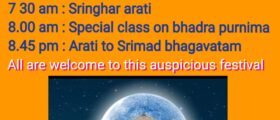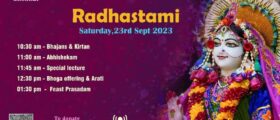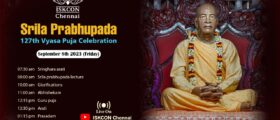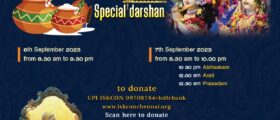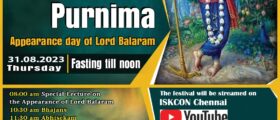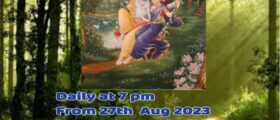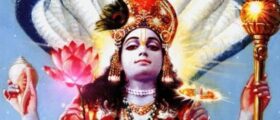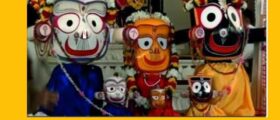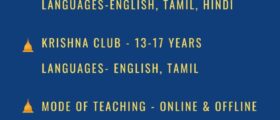Ratha-yatra, The Festival of Chariots
Baladeva, Subhadra, Jagannatha
Right to left: Lord Jagannatha, Subhadra Devi, and Lord Baladeva
Ratha-yatra, or the Festival of Chariots, is a joyous event celebrated for thousands of years in the Indian holy city of Jagannatha Puri, and more recently by Hare Krishna devotees in cities around the world. Another name for Krishna, Jagannatha refers to the ecstatic form of the Lord with large eyes and rugged features who is carried on a gigantic chariot during this festival (and worshiped in an ancient temple at the center of Jagannath Puri.)
As the story goes, Lord Krishna once overheard a conversation about how His dearest devotees, the cowherd maidens of Vrindavana, were lamenting in His absence. When He heard these accounts of overwhelming love in separation, the Lord’s hair began to stand on end, His eyes opened wide and filled with tears, and His arms and legs contracted as He went into a state of spiritual ecstasy. Seeing Lord Krishna in this condition, His elder brother, Balarama (Baladeva), also began to feel ecstatic symptoms and displayed similar features. When Their sister, Subhadra, arrived at the scene, she too became consumed with ecstatic joy. Thus the sublime deity forms of Jagannatha, Subhadra, and Baladeva represent this sweet pastime.
The festival of Ratha-yatra represents Lord Jagannatha’s longing to reunite with His dear devotees in Vrindavana, foremost among them, Srimati Radharani. According to tradition, the Lord gets lovesick once a year just prior to the festival. To cheer him up, His servants arrange for Him to go on a lavish procession to meet up with His devotees. Lord Jagannatha rides on a grand, three-story-high chariot, accompanied by thousands of onlookers and marching bands with scores of drummers, singers, and dancers. India’s colonial British rulers coined the term “juggernaut” from the large, heavy chariot used to celebrate this festival in the city of Jagannatha Puri.
Five hundred years ago, Lord Chaitanya Mahaprabhu, the combined incarnation of Radha-Krishna, encouraged all of His followers to celebrate Ratha-yatra with great enthusiasm. His biographies (such as Chaitanya Charitamrita) list many anecdotes surrounding the Ratha-yatra festival. It is said that Chaitanya Mahaprabhu got down on His hands and knees to scrub the Gundicha temple where Lord Jagannatha would stay at the end of the Ratha-yatra parade.
Srila Prabhupada, the founder of the Hare Krishna movement, was very fond of Ratha-yatra. As a child he began celebrating Ratha-yatra when he was five years old, using a small home-made cart and pulling it around the neighborhood with his friends. Later in life, from 1967 until his passing, Srila Prabhupada joined thousands of disciples in cities around the world as they celebrated elaborate Ratha-yatra chariot festivals in the streets of London, Paris, Sydney, Tokyo, San Francisco, Los Angeles, and on New York’s prestigious Fifth Avenue.
Today, Hare Krishna devotees hold Ratha-yatra parades in many cities, usually culminating in a “Festival of India” set up in a city park, with festival tents, entertainment stages, free-feast booths, and a variety of cultural displays and exhibits. Contact your nearest Hare Krishna temple to find out about Ratha-yatras in your area.
Ratha-yatra signifies the Lord’s love for His devotees. He personally comes to visit His devotees and the public who welcome Him in the streets. Befitting the sentiment of its origins, Ratha-yatras in the Hare Krishna movement also serve as reunions for devotees who come from far and wide to participate, meeting up with old friends around their common goal of serving Lord Jagannatha, Sri Krishna.
On the 25th of June 2023 Iskcon chennai is celebrating Lord Jagannath Rath yatra .
We kindly request all of you to participate in the Rath yatra and get Lord Jagannath’s mercy .
Jagannatha Ratha Yatra
History of Jagannatha Puri
Jagannatha Puri, located on the eastern coast of Bharata (India) in the state of Orissa (originally called Utkala or Udradesh), is a prime pilgrim centre in South Asia. The four famous param-tirthas (primary pilgrim centres known as Chardham) in Bharata are Badrinath established in Satya yuga, Ramesvaram in Treta yuga, Dvaraka in Dvapara yuga, and Jagannatha Puri in Kali yuga. The Puranas mention that the ancient Puri temple extends up to 10 yojanas (approximately 80 miles in diameter) and it was manifested from the ocean and covered by sand and at the middle of the sandy beach is the blue mountain. Although Jagannatha Puri, originally called Purushottama Kshetra, was founded in Satya yuga by King Indradyumna as the Narada Purana, Uttara- bhaga 52 and 57, mentions, it became famous only in this age with the installation of the Deities of the Supreme Lord Krishna along with Balarama and Subhadra in its sanctum sanctorum. The scriptures say that only pious people are eligible to visit Puri and meeting Jagannatha will wash off their sins in the past lives and lead them to liberation from the fetters of endless miserable life in this karma-bhumi.
puruSAkhyAM sakRd dRStvA sAgarAntaH sakRn mataH
brahmavidyAM sakRjjJAtvA garbhavAse na vidyate
By visiting at least once PuruSottama on the ocean shore, by knowing brahmavidyA once, one will not know another womb (i.e. will not be born again). (Narada Purana 2.52.25-26)
cakraM dRSTvA harer dUrAt prAsAdo pari saMsthitam
sahasA mucyate pApAn naro bhaktyA praNamya tam
By seeing from even a great distance the disc of Hari on the temple top and bowing down to it with devotion one will be immediately liberated from one’s sins. (Narada Purana 2.55.11)
Lord Jagannatha (Lord of the universe) represents Lord Krishna residing at the middle of the mammoth temple complex of Puri. According to the Mahapuranas, the coronation of the Deity carved out from wood by Vishvakarma was performed by Lord Brahma in Satya yuga. Lord Jagannatha told Indradyumna that He originally appeared in the first manvantara of Svayambhuva Manu approximately 1 700 million years ago based on Vedic calculations. In memory of the installation of the holy Deity, the snana-yatra (public bathing) ceremonies carrying Jagannatha on a huge ratha (chariot) are held annually at Puri and the first of its kind was celebrated in the second manvantara of Svarochisha Manu. From then the festival became famous as Ratha yatra. An episode in the Uttara khanda (108.30) of Valmiki Ramayana reveals that just before Lord Rama’s departure, He advised King Vibhishana of Lanka to worship Lord Jagannatha, the Lord of the Ikshvaku (the son of Vaivasvata, the current Manu) dynasty in which Lord Ramachandra appeared. The Ratha yatra festivities are held annually in the month of Ashadha (May-June) on the day of the Pushyami star as the Skanda and Narada Puranas tell. The story of the Purushottama Kshetra is also told in the Padma Purana as Sanatana Goswami mentions it in the Dig Darshini Tika of his Brhad Bhagavatamrta (2.1.159). The Deity of Jagannatha is said to be perfectly spiritual, though originally made of wood.
About 500 years ago Chaitanya Mahaprabhu (an incarnation of Lord Krishna) remained at Jagannatha Puri and danced always in the Ratha yatra festival. Nityananda Prabhu (an incarnation of Lord Balarama) always joined Lord Chaitanya in the procession together with several of Their associates. Lord Chaitanya was present at Jagannatha Puri for 18 years.
The Puri Temple Complex
The temple records reveal that the major temple complex called Shri Mandir was built in the 12th century by King Chodaganga Deva (Anangabhima Deva) and it houses as many as 4000 – 5000 priests and covers an area of approximately one acre bounded by stone walls with a gate on each of the four sides. The 25ft high outer wall (655ft x 640ft) is called Meghanada and the inner wall 420ft x 315ft is called Kurma-prachir. The gopura of the main shrine is said to be 215ft tall and houses the six foot tall Deities of the three divine siblings on a five foot high holy dais. The small surrounding shrines are said to be later additions of the 16th century and they house around 100 devas.
The Jagannath Puri temple is a combination of the Dravidian and Nagara architecture. The architectural excellence of the temple is evident from the carvings and construction details. In the stone borders and door frames can be seen the beautifully sculptured 24 forms of Lord Vishnu. The main temple consists of four distinct buildings: (1) Bhoga-mandapa: an 18m x 17m hall for the food offerings to Lord Jagannatha and consists of beautiful sculptures and paintings of Krishna-lila. (2) Nata Mandapa: is a spacious music and dance hall (21m x 20m). (3) Jagamohana (Mukhashala): This is the visitor’s hall to see the Deities of Lord Jagannatha, Balarama and Subhadra. Three Garuda-sthambhas are located here from where Lord Gauranga took the daily darshan of Vrajendranandana Jagannatha Deva. (4) Vimana: (Bada-deula or Garbha-grha): This is the inner sanctum, the main altar (ratna- simhasanam) for the Deities of Jagannatha, Baladeva, Subhadra, Sudarshana, Lakshmi, Sarasvati and Nila-madhava.
Daily artis are held six times a day from 4 AM to 9 PM in the main temple. Devotees throng up in large numbers to worship the deities and they ecstatically dance, sing in groups, and chant Lord’s holy names. Several cooks work in the large kitchens and prepare 56 varieties of delicious food offerings (chappanna-bhoga) for Lord Jagannatha and the remnants of the prasadam are served to the tens of thousands of devotees visiting the temple every day. The food offerings include 9 rice preparations, 14 subjis and curries, 9 milk preparations, 11 sweets, and 13 cakes, pancakes and patties. The delicious variety of foods offered daily to Jagannatha include plain rice, ghee rice, ghee sweet rice, dry sweet rice, yogurt rice, plain kichari, sweet kichari, ginger rice, and lemon rice. The timing of the six bhoga offerings to Jagannatha every day are (1) Gopala-vallabha-bhoga at 8.00 AM, (2) Sakala-bhoga at 10.00 AM, (3) Bhoga-mandapa-bhoga at 11.00 AM, (4) Madhyahna-bhoga at 12.30 PM, Sayana-bhoga at 7.00 PM, and Bada-srngara-bhoga at 11.15 PM. The Gopala-vallabha-bhoga is the morning breakfast offering consisting of milk sweets, fruit, butter, yogurt, coconut, malai, etc. The Sakala-bhoga (Raja-bhoga) contains various preparations of black gram like bada kanti, sana kanti, enduri, mathapuli, hamsakeli, kakatua, jhili, kichari, etc. The Bhoga-mandapa-bhoga is prepared in large quantities for mass distribution as prasadam. The Madhyahna-bhoga consists of rice, dal, subjis, etc. The chefs still work under the traditional oil lamps and they can prepare food for ten thousand devotees at an instance. There are nine kitchens and each is around 2500 square feet in area. It is said that 752 stoves (chulas) fuelled by wood are used in the kitchen. The kitchenware mainly includes the traditional clay pots of various sizes and shapes. One thousand well trained cooks work daily, although the kitchen can accommodate four to five times the number.
Ratha yatra
The Ratha yatra falls in the summer season of May-June each year and Puri becomes a vibrant scene of crowd attraction during the festival. Perhaps a million plus gather to witness the tumultuous event. This is one of the ancient festivals in Bharata and a place of huge crowd attractions like the Kumbha-mela, Makara-sankranti, and Pongal festivals. The Ratha yatra festivities are organised and financed mainly by the Government of Orissa. As said, during the Ratha yatra, the three Deities are sailed out for public view from the temple seated on huge chariots (ratha) moved on wheels and pulled by large crowds. This is the rare occasion when everyone can see Them freely since the temple entry is forbidden to all but ethnic Indians. This continues to be a controversial issue. Ban supporters could quote verses like Parama samhita 21.49 but to consider non-Indian Vaisnavas unclean is offensive:
azuci dravya saMsarga jana saMsarga eva ca [vA?] prAsAde varjayed viSNor lokopakaraNAni ca
Exclude from the temple of Visnu any collection of things unclean and the collection of unclean people; also things in daily use by people should be kept out.
New carts are constructed from fresh wood each year and the construction begins a couple of months ahead of the festival, precisely on the third day of the bright fortnight of Vishakha (April-May). The three carts are manufactured using over 1000 logs (around 400 cubic metres) of wood collected mainly from the forest on the banks of River Mahanadi. Approximately 1200 metres of cloth is consumed annually and 14-16 tailors stitch covers to suit the Rathas. The nails, brackets and fixtures are supplied by local manufacturers. The main structure of the Ratha consists of 18 pillars and roofs. The carts carrying the canopies may reach 14-16 metres tall and brilliantly painted. The colour of the chariots identifies the Deity it carries. Red and yellow are preferred for Jagannatha, red and green for Lord Balarama, and red and black for Subhadra. (The colours of the Deities are black for Jagannatha, white for Balarama, and yellow for Subhadra.) The cart of Jagannatha is called Candradhvaja or Nandighosha (blissful sound vibrations) and it is supported on 18 wheels and stretches approximately 45 feet tall and weighs 60 – 70 tons and is painted yellow. Four white wooden horses draw the chariot and the crest of the Ratha is marked with an emblem of Garuda, the Lord’s celestial carrier. In addition, a chakra also distinguishes the cart. The blue ratha of Lord Balarama is called Taladhvaja (strong sounds) with 16 wheels and it is approximately 44 feet tall and drawn by four dark wooden horses and carries the emblem of Hanuman atop. The black cart of Subhadra is called Padmadhvaja or Darpadalan (annihilator of pride) and is supported on 14 wheels and approximately 43 feet tall and drawn by four red wooden horses. Each wheel is said to be approximately two metres in diameter. The Deity protecting Jagannatha is said to be Narasimha, that of Balarama Shesha, and of Subhadra Vanadurga. On each Ratha are seated many wooden Deities such as one parshva-devatas (close associates of the Divinity), two dvara-palakas (door keepers), one sarathi (chariot driver), and one dhvaja devata (presiding Deity). The Rathas are decorated with flowers as well.
The Deities are bathed in public two weeks before the festival and it is called Snana-yatra. Special offerings are made to the Deities thereafter on specific locations. At the beginning of the Ratha yatra the priests arrive at the cart and sprinkle holy water walking around it three times and chant the holy Vedic hymns. Then the priests bring the small Deities that move with the carts. The Sudarshana-chakra will be first moved to Subhadra’s cart. Then the three main Deities are brought out in order as Lord Balarama first, Goddess Subhadra next, and then Lord Jagannatha. Many musical troupes blow horns and cymbals and beat drums at the main gate to invite the Deities. The Deities are moved with the heads covered on clothes and when They arrive at the carts, the coverings are removed. Massive crowd will be drawn in to witness the occasion and they chant the names of the respective Divinities and sing Their glories when the Deities are moved out. Then the Deities are beautifully decorated and worshipped paying floral tributes.
To accommodate the three huge chariots built like a temple sanctuary, the street from the Puri temple to the garden temple is made very wide. Various colourfully decorated temples, saintly ashrams, hotels, shops, and large ancient aristocratic buildings are seen on either sides of the parade road. Well dressed up women flock up atop the buildings and balconies to witness the Ratha yatra.
The Deity of Balarama is 5 feet and five inches tall, Goddess Subhadra is a bit short of 5 feet, and Jagannatha is 5 feet seven inches erect. The Deities are identified by special signs and marks as well. Around 50 – 80 strong men are engaged to carry the Deities and the carriers are said to be from the lineage of Vishvavasu. The Deities are moved from the temple to the chariot in the order of Balarama first, Subhadra second, and Jagannatha last. The King of Puri sweeps the cart floor with a broom made of golden handle accompanied by his accomplices and move around the chariot sprinkling scented holy water followed by priests, and it happens in the morning. Then the wooden stools are removed and the wooden horses are mounted in the direction of the journey. Nearly 4000 devotees gather to pull the chariots with long ropes made of coconut fibre (eight inches in diameter) through the main roads. Blowing a long whistle by the captains of the procession, the Ratha yatra begins. Music bands blow horns, cymbals and other instruments along with various drums. Massive crowd witness the grand procession watching from both sides of the street and from balconies and rooftops. Loud shouts of “jai jai Jagannatha” shrill the atmosphere and the parading men raise their hands and dance in joy. The Ratha yatra (chariot parade) starts in the morning and stops at noon for food offerings near the Jagannatha Vallabha Gardens. Group sankirtanas (congregational chanting) are organised to glorify the Lord and chant the holy names, and numerous devotees gather to worship the Divinities. The priests bath the Deities in panchamrta and cool water, and offer naivedyam and aratis. Then the chariots are drawn to the Gundicha (named after the wife of King Indradyumna) temple located at Sundaracala hill (beautiful hill) about a couple of miles away from the Jagannatha’s abode. Then arati is offered and the Deities are taken in the sanctum of the Gundicha temple, where they rest for a week or more. After arrival a feast of Krishna-prasadam is served to all participants.
The Gundicha temple is called Mahishi-badi (the home of Jagannatha’s aunt). The Jagannatha Puri Guide Book by Mahanidhi Swami tells of a Puranic verse to extol Gundicha:
gundica mandapam yanti ye pasyanti rathe sthitam
krsna-ramau subhadram ca te yanti bhavanam hareh
ye pasyanti tada krsnam saptaham mandape sthitam
halinam ca subhadram ca visnulokam vrajani te
“Whoever comes to Gundicha temple during Ratha yatra and sees Jagannatha, Balarama and Subhadra will have his mind turned towards Lord Hari. If he sees the Deities while They remain there for seven days on the throne of Gundicha, he will go to Vaikuntha.”
The ceremonies at Gundicha are not as elaborate as in the main temple. Various celebrations are organised during the brief stay of the Divinities in the garden temple. It is presumed that on the 5th day (Hera-pancami) of lunar fortnight, Lakshmi will be out searching for Jagannatha accompanied by Lord Shiva and her maidservants. Seeing her arrival, the servants of Jagannatha close the gate the Gundicha-mandira and the door of the bhoga-shala. Lakshmi gets wild and breaks Jagannatha’s Ratha. Frustrated Lakshmi waits long and then dines there and returns to the Puri temple.
On the ninth day of the lunar fortnight, the return Ratha yatra begins and it is called Bahuda-yatra. Lakshmi and her servants arrive to invite Jagannatha and the Lord removes His garland and adores her. While returning, the chariot of Jagannatha stops at Ardhasani temple (Mausa Ma temple) and the poda pitha (rice cake) will be offered to the Lord. The return journey starts in the morning from Gundicha and reaches at the main temple by the evening. The return journey will be similar to the onward with all pomp and glory, and Lord Jagannatha and associates are brought back to Puri after a trip of seven or more days. Sometimes the departure will be delayed and may continue to stay at the garden temple for more than a week based on the lunar calendar. The departure from the Gundicha temple is a replica of events from Puri. The return journey is not popular as the onward and only a lean crowd will witness the procession.
The process may not be trouble free always. Sometimes mishaps may happen such as running off road, ramming on embankments, or abrupt stoppage of carts on the way. If the carts can’t be rescued in time, the leaders and priests pray to Lord Jagannatha and then astonishingly the carts start moving freely as before. It someone is caught in the crowd in front of the procession, it may need a stupendous effort to squeeze through and give way for the carts, and in the struggle may be stampeded as well. Sometimes, the procession will be delayed due to stoppages in between. All through the procession, rumbling of large cart wheels mix with loud chants and roar of joy laud the ears.
Reaching Puri, the Deities are out in the open for public view and offer Their blessings. A huge crowd again throng up to witness Jagannatha and His compatriots. On the third day a suna-vesa festival is organised and Deities are adorned in gold including all their ornaments and outfits. It is said that around 800 – 1000 kilos of pure gold are used for this event. Except the close servants of Jagannatha others are disallowed to witness the suna-vesa event at close ranges. The adorned Deities with the yellow metal will be then open for a day to the public for close viewing and a controlled crowd will line up and witness the majestic Deities. Close to sunset, the Deities will be carried back to the Puri temple and the retreat events follow that of the ejection from the temple, marking the end of the glorious annual Ratha yatra festival.
Significance of Ratha yatra
Intricate sentiments symbolise the grand Ratha yatra festivities connecting the event with the return of Lord Krishna to Vrindavana from His pompous life in Dvaraka to meet His heart throbs. The palace of Dvaraka represents the residence of Jagannatha, an enticing enactment of Lord Krishna’s scintillating pastime. At Puri Krishna and His fraternal associates dwell as living Deities to wipe off the sufferings of His devotees in this mutilated age of Kali yuga. The Gundicha represents the Vrindavana, where His eternal associates Radharani, the gopis and gopas dwell. The visit of Jagannatha to Gundicha symbolises the visit of Shyamasundara to meet His youthful associates of Vrindavana and the seven days stay there reminds His enchanting moments of rasa-lila with the loving company of their association. Many have enacted this colourful event and many have coined articulating words of gesture to glorify their touching love of Lord with the glories of Vrindavana.
Engrossed in separation with Radharani, Lord Krishna travelled to Kurukshetra from Dvaraka accompanied by Balarama and Subhadra and met Radharani, His ever loving friend in Goloka Vrindavan. Dragged in ecstatic love, Krishna was arrested in sentiments and His limbs dragged in His body. Lord Chaitanya was the manifest love of Radharani and He carrying Jagannatha to Gundicha reminds Radharani wanting to take away Lord Krishna from Dvaraka to Vrindavana.
The glories of Ratha yatra
O Emperor, all the sites blessed by the glance of Lord Damodara in the course of the Ratha-yatra which follows His awakening, should be considered equal to svarga. O leader of humanity, while pulling Sri Krsna’s ratha, every step becomes as good as a Vedic sacrifice. Dog-eaters achieve the status of demigods when they watch Kesava on His ratha, even if they do it out of mere curiosity. (Padma Purana/Karttika Mahatmya 340-343)
Even dog-eaters achieve Lord Visnu’s association when they walk in front, behind, or on the sides of the ratha; on the other hand, even scholarly brahmanas become dog-eaters if they neglect Lord Janardana’s Ratha-yatra. (Padma Purana/Karttika Mahatmya 381-382, quote from Bhavisya Purana)
Narada Purana, Uttara khanda 52.70-71, reveals the conversation between Lord Narayana and Lakshmidevi about Purushottama kshetra (Jagannatha Puri):
pratimAM tatra tAM dRSTvA svayaM devena nirmitAm
anAyAsena vai yAnti bhavanaM me tato narAH
A person who once sees the Deities there built by the Lord Himself will easily find the path to reach My abode.
ratha-sthaM vAmanaM caiva nirvANaM dRSTi-mAtrataH
When Vamana is seen on the chariot (ratha), the seer attains nirvANa (moksa). (Narada Pancaratra 2.7.16)
It is said: “A person who sees Lord Govinda on His swing, Lord Madhusudana on His altar, and Lord Vamana on His chariot will not take birth again.” (Bhakti ratnakara 5.3790)
Rathayatra benefits are listed in Narada Purana:
2.61.34 liberation even from brahma-hatya etc.
2.61.35 parikrama of the whole earth three times
2.61.36 equal to result of pilgrimages in the whole earth
2.61.37-41 benefit of bathing in many tirthas mentioned in sastras
2.61.42 guNDicA maNDapaM yAntaM ye pazyanti rathe sthitam
sa bhadraM sa balaM kRSNaH te yAnti bhavanaM hareH
Those who see Krsna seated on the chariot along with Subhadra and Balarama and proceed to Gundica Mandapa go to the abode of Hari.
2.61.43 guNDicA yAna samaye phAlguNyAM viSuve tathA
sakRd yAtrAM naraH kRtvA viSNulokaM pragacchati
By even one pilgrimage, at the time of journey to Gundica, at the time of equinox on the month of Phalguna, one goes to the world of Visnu.
2.61.44 It is certain that one will stay in the world of Visnu for as many kalpas as the number of pilgrimages he undertakes to Sri Purusottama.
Anyone seeing the Deities of Lord Krishna, Balarama and Subhadra at Jagannatha Puri during Their Ratha yatra is buying a ticket to reach the supreme abode of Vaikuntha. The Lord promises that His devotees who take all pains to gather at Puri during the Ratha yatra will be rid of their miseries and may reach the eternal abode of Goloka Vrindavana and enjoy their life in association with Lord Krishna, Radharani and their close accomplices.
It is said that the participants in the festivities will be blessed immensely by Lord Jagannatha (Krishna) such as (1) By the sight of Jagannatha’s merciful large two eye globes, the devotee will be blessed with astute purity of mind and spiritual elevation; (2) Observing the Ratha yatra will dissipate the sins committed by the embodied person in the past births; (3) The accompanying person in the Ratha yatra will receive opulence at par with Lord Vishnu even if he hails from a poor family; (4) Dancing, singing and chanting in the Ratha yatra entourage, the participant will be elevated to a level superior to yogis; and (5) Active participation in the Ratha yatra by any means will receive the utmost blessings of Lord Jagannatha.
Yet there is also a warning against non-participation:
nAnuvrajati yo mohAd vrajantaM jagad-Izvaram
jJAnAgni-dagdha-karmApi sa bhaved brahma-rAkSasaH
He who does not follow the Lord in His chariot when he moves becomes a brahma-raksasa even though he has destroyed all karmas with the fire of knowledge. (Visnu-bhakti-candrodaya from a Purana, quoted by VCT in Sarartha darsini to SB 1.5.12)
The glories of Ratha yatra imprint in mind the love of God to His devotees. Srila Prabhupada said, “If you participate in these car festivals, as stated in the scriptures, rathe ca vanam drstva punar janma na vidyate… If you kindly see these Jagannatha deities riding on these cars or these processions, and as Chaitanya Mahaprabhu chanted the Hare Krishna mantra in front of this car, then according to the Vedic scripture, in your next life you’ll go back, back to Godhead.” Those who participate in the festival have a food for thought in the years to come and it may drag down even to the final moments of their life to affix the attention in the eventful pastimes of Jagannatha as Krishna tells in Bhagavad Gita (8.5-6):
anta-kale ca mam eva smaran muktva kalevaram
yah prayati sa mad-bhavam yati nasty-atra samshayah
yam yam vapi smaran bhavam tyajaty-ante kalevaram
tam tam evaiti kaunteya sada tad bhava bhavitah
“Towards the end of life and at the time of departing the body, he who remembers Me will undoubtedly attain My nature. Whatever a living being thinks at the time of leaving his body, that alone he attains for being always absorbed in that state.” Those devotees who always chant and prostrate at the holy feet of Lord Jagannatha uttering the mahamantra (HARE Krishna HARE Krishna Krishna Krishna HARE HARE HARE RAMA HARE RAMA RAMA RAMA HARE HARE) ordained by the Lord Krishna Himself in the form of Chaitanya Mahaprabhu and propagated all over the world by Srila Prabhupada will be blessed with perfect devotion to God forever, which is said to be superior to liberation.
Chaitanya Mahaprabhu and Ratha yatra
Chaitanya Mahaprabhu’s participation in the Ratha yatra is described in the Madhya-lila 13 of Sri Caitanya Caritamrta, “The ecstatic dancing of the Lord at Ratha yatra,” and it is briefed here. As said before, the miraculous pastimes of Lord Chaitanya’s dancing exhibited during the Ratha yatra was a fascination to the crowd five centuries ago. After an early morning bath, Mahaprabhu took darshan of the Deities (Jagannatha, Balarama and Subhadra) and got on to Their carts, and that glorious occasion is called Pandu vijaya. His close associates Nityananda, Advaitacarya, Shrivasa, Ramai, Raghu, Govinda, Mukunda, Haridasa, Govindananda, Madhava, and others accompanied Him. Svarupa Damodara was made a main troupe leader. They sang and danced around the Lord. Worshipping Lord Jagannatha, Chaitanya Mahaprabhu prayed, “My obeisance to Sri Krishna adorable to all brahmanas, the bestower of cows and pious humans, and the world’s beneficiary, I worship You again and again, You Supreme Person, o Krishna, o Govinda. All glories to You the Supreme Lord, the son of Devaki. O the Supreme One, You are the light of the Vrishnis, O glorious One, Your body is bright as a new rising cloud in sky and soft as lotus petals. All glories to You, who arrived on earth to rescue her from the tread of demons, o liberator of all. O Krishna, O the utmost destination of all, o son of Devaki, o son of Yashoda, You directed the Yadus with Your almighty arms and dissipated all impious and inauspicious omens. Your presence destroyed all wicked life among the movables and immovable. Your blissful smile aroused lust among the damsels of Vrindavana. O glorious Person, please dwell in happiness. I am neither a brahmana, kshatriya, vaishya, or shudra nor I am a brahmachari, grhastha, vanaprastha, or sannyasi. I am an insignificant servant of the servants of the servants of the lotus feet of Krishna, the lover and protector of gopis. You are an ocean of nectar, the transcendental bliss, and may You ever dwell in glory.”
When Chaitanya Mahaprabhu danced, jumped high and moved in circles, He appeared like a whirling firebrand. While He roared and treaded, the whole earth, hills and seas appeared trembling. Many blissful transcendental emotions transpired in the Lord when He danced. His bodily hairs stood on end in ecstasy, and He sometimes cried aloud, trembled and perspired. Occasionally His body appeared in various hues and aroused emotional symptoms of humility, arrogance, peace and agitation. Sometimes He crashed on ground and rolled like a mad man and sometimes Nityananda Prabhu stretched out His hands to behold the Lord, while Advaita Acharya walked behind and chanted aloud, “Hari bol, Hari bol….” To protect the Lord from the crowd, they moved in three concentric circles and bounded with locked hands and Nityananda Prabhu secured the inner circle. Devotees like Kashishvara, Govinda and others formed the second circle, while King Prataparudra (said to be King Indradyumna reborn) locked hands with Harichandana and other royal guards framed the third circle. All danced ecstatically in circles with their attention affixed on Lord Chaitanya. Even the manifest Deities were keen watching the ecstatic dance of Chaitanya Mahaprabhu exhibiting the eight glorious mellows of perfect bhakti-rasa and His body appeared like a thorny silk cotton tree with erect hairs and eruptions of blood and sweat. Tears sprayed from His eyes wetting his accomplices and He turned pink. Occasionally, He looked stunned, stood firm, and unmoved, and His body became hard like wood. Sometimes, He fell down and rolled, or lied breathless with flowing tears, wet nose, and foaming mouth. Devotees like Shubhananda tasted the eruptions of His embodiment like nectar flown from moon. When Chaitanya got up, He asked Svarupa Damodara to sing and he sang, “I have now got the Lord in my life and Cupid wandered me bereft of Him.” Hearing it, the Lord danced again exhibiting his ecstasy.
As the carts moved on, Nitai and associates took to the front of Jagannatha and danced, and it was a majestic show of mellows to all participants and onlookers of the Ratha yatra. Occasionally the Lord and His sankirtana troupes sang and danced at the trail of the rally as well. Sometimes Jagannatha’s car stopped when Mahaprabhu moved down and then He moved up and danced in front and the car starts again to the astonishment of all spectators. It showed a test of love between the giver Jagannatha (Krishna) and receiver Gaurasundara (Radharani) and it proved that the provider will function only in the presence of the real lover, which exemplifies the significance of perfect bhakti to the devotees.
The Madhya-lila 13.1-2 with the translation of Srila Prabhupada tells:
sa jiyat krsna-caitanyah
sri-rathagre nanarta yah
yenasij jagatam citram
jagannatho api vismitah
“May the Supreme Personality of Godhead, Shri Krishna Chaitanya, who danced in front of the car of Shri Jagannatha, be all glorified! By seeing His dancing, not only was the whole universe held in wonder, but Lord Jagannatha Himself became very much astonished.”
jaya jaya sri-krsna-caitanya nityananda
jayadvaita-candra jaya gaura-bhakta-vrinda
“All glories to Shri Krishna Chaitanya and Prabhu Nityananda! All glories to Advaitacarya! And all glories to the devotees of Lord Shri Chaitanya Mahaprabhu!”
Srila Prabhupada spreads Ratha yatra world-wide
The significance of Ratha yatra reached the far corners of the globe now and especially where ISKCON temples are located ever since Srila Prabhupada organised the first Ratha yatra in San Francisco in 1967 as briefed below. The Ratha yatra was scheduled on a Sunday the 9th July. On Saturday, 8th July, Jagannatha Deities were brought from Stinson Beach and draped in cloth. Although some Ratha yatra posters were the only official announcements, everyone in the Haight-Ashbury was talking about the festival. A Krishna parade to the beach! A love feast! Bring flowers, wear bells, paint up, chant, and get high! Celebrate Shri Jagannatha, Lord of the universe!
On Sunday, 9th July, Shyamasundara Prabhu brought the flat bed truck on which the chariots were mounted and the Deities were installed, undraped and garlanded Them with hibiscus. Lord Jagannatha was placed on the right side of the cart beneath the foldable canopy engineered by Jayananda Prabhu. While placing the Deity, the devotees sang jagannatha-swami nayana pathagami bhavatu me, “O Lord of the universe, please be visible unto me.” Subhadra looked out from the rear, and Lord Balarama was seated on the left. On the cart’s four corners were placed Christian, Muslim, Jewish, and ISKCON flags. The ISKCON flag consisted of a Sanskrit AUM and a drawing of a dancing pair of Radha and Krishna.
Srila Prabhupada said, “Actually, each Deity should ride in a separate cart and the carts should be pulled with ropes by the crowds through the streets. But that is all right. May be in the future you can arrange that.” Music and kirtans were sung all way through the parade. The girls were dressed in saris, and the gents wore dhotis and kurtas. Drums, cymbals, and tambourines were played in rhythm, and the crowd started chanting Hare Krishna. The girls handed out oranges, apples, bananas, chapatis, and puris to all those came near. As Shyamasundara Prabhu drove down the car to Haight, people lined up the sidewalk and flowed out into the street to follow the cart, while Lord Jagannatha kept smiling. Frequently the cart slowed to a halt as people clustered around the dancing devotees in front of the car. Flowers, apples and kisses were distributed to those hippies flocked up and the crowd roared “Radha Krishna Temple ki jai! New Jagannatha Puri ki jai!” The crowd and hippies all chanted the Hare Krishna mahamantra. Finally, the cart reached the Pacific beach of San Francisco with some hitches on the way. Soon Srila Prabhupada also arrived at the beach and together they ate the prasadam and everyone was elated. All listened to Srila Prabhupada about Jagannatha Puri and Vaikuntha while partaking the prasadam. Prabhupada said, “As long as we are in the ocean of material nature, we will feel anxiety, but not in Vaikuntha. That is what Vaikuntha means, freedom from anxiety. Everyone in the material universe – from Lord Brahma down to the tiny ant – is anxious about something. If you see a bird and make a sudden move, that bird will fly away from fear. He is anxiously thinking, ‘Oh, what will catch me and eat me?’ The Padma Purana says that the smaller living entities serve as food for the larger. So all are in anxiety, even Brahma himself, for although his years are incalculable by our system, there is finally annihilation.”
The Deities are to remain some days at Paradisio before returning to the temple. Then the devotees packed back in the empty truck and their vehicles. Srila Prabhupada said, “That was but the beginning.” Prabhupada said the following morning. “We will inaugurate many such celebrations all over the world. One by one, I will show you.” That was the beginning of the first Ratha yatra outside Bharata. Where Ratha yatra procession is not held, a special puja followed by great feast will be organised to all ISKCON devotees in memory of the great festival and many visitors too join for the sumptuous Krishna-prasadam distributed and receive the blessing of Jagannatha, Lord of the universe.
It remind us Srila Prabhupada’s childhood pastime in building rathas (carts) and organising yatras (processions). When he was barely six, Abhay (original name of Prabhupada) wanted to organise a brief Ratha yatra imitating the grand procession held at Calcutta. He was also enthused at Mahaprabhu’s ecstatic dancing before the Ratha yatra at Puri four hundred years ago. Abhay insisted his father Gour Mohan to buy a decent ratha for him. The father and son visited many carpenters to see some models they could chose from, but the price was unaffordable. Soon an old woman arrived at home. Seeing the worried Abhay, she enquired, “Why young Abhay is worried?” From Abhay’s mother Rajani, the woman understood about his ardent love for a ratha. The woman said, “I have a cart at home. Come and take it.” Gour and Abhay went and bought it. The wooden cart was small, but of decent size for the kids to smart on. They fixed wooden horses to the carts and painted and decorated them to resemble like the original rathas of Puri. Abhay’s sister Bhavatarini also helped him to ornament the Jagannatha Deities. Abhay collected his friends and organised a Ratha yatra on streets of Calcutta. It resembled like a fair mini replica of the original Puri Ratha yatra. It showed the young Abhay’s interest towards Ratha yatras and it infused confidence in the growing mind to later build upon his talent to organise large scale Ratha yatras all over Bharata and across the globe. Abhay’s immense love for Radha-Krishna and Jagannatha Deities from childhood was inherent and God gifted, and those holy hands later blessed millions of people to become dear devotees of Gauranga and follow His path to worship Radha-Govinda and participate in the colourful of Ratha yatra festivities world-wide.
In USA, esp. L.A., our Ratha yatra is accompanied by protests by fanatic Protestants who think Lord Jagannatha is some evil pagan demon. This is the result of stupidity. Jesus at Ratha yatra against fanatics.
Appearance of Lord Jagannatha
Q: It will be very kind enough of you if you let me know about the appearance of Lord Jagannath. When did He appear and what was the purpose of His appearing in that form?
A: (Romapada Swami) The manifestation of Lord Jagannath is transcendentally wonderful. His appearance in that form is described by Jaimini Rsi in Skanda Purana to an assembly of sages. The story of King Indradyumna who became the first worshiper of Lord Jagannath, and his life’s expression of devotion, is in itself a great delight. In short, the king was exceedingly eager to see the form of Lord Vishnu on this earth, and at the end of a sequence of miraculous events, the Supreme Lord had revealed through His representatives Narada and Lord Siva that He would appear in a `daru’, a wooden log, and that Vishvakarma would carve His form from that transcendental log. Vishvakarma had stipulated that he not be intruded upon for 21 days during the carving, but when there was a break in the chiseling sound, the greatly anxious king hastily came into the room where the Deities were being carved, only to find what he thought to be unfinished forms of the Deities. The king was in utter despair, thinking that he had committed a great offense. But Sri Narada Muni pacified him by explaining that it was the Lord’s transcendental will to manifest in that particular form.
Then Narada narrated the following pastime of how the Lord had originally manifested this extraordinary form that was now before the king.
Once the residents of Dvaraka became very eager to hear about the childhood pastimes of Krishna in Vrindavana. They knew how attached their Lord was to Vraja and its residents, but they did not know much about His pastimes there.
So they inquired from Rohinidevi, the mother of Balarama and one of the wives of Vasudeva, who happened to stay in Vrindavana with mother Yasoda during the entire childhood of Krishna-Balarama. Rohini was of course very happy to oblige, but there was one concern: if Krishna happened to overhear the glories of the love of the residents of Vrindavana, His feelings and transcendental emotions of separation from them would become attract the attention of Krishna to such a degree that His ecstasies would prevent Rohini from completing her narration of Krishna’s Vraja-lila. Therefore Subhadra devi, the sister of Krishna, volunteered to guard the door and keep Krishna from entering the room where Rohini’s Vraja-katha was taking place. But as Rohini devi started recounting the wonderful pastimes and the depth of intimacy in the loving exchanges between Krishna and the Vrajavasis, Subhadra devi became stunned. Just then Krishna and Balarama came and stood on either side of her hearing these narration and They too became stunned. Their eyes became wide, and in a mood of indescribable ecstasy, Their hands and feet retracted within Their bodies. This is the form of Lord Jagannath – Krishna in Dvaraka, enraptured and overwhelmed in thinking about the unrepayable and intense selfless love of His Vraja-bhaktas.
Narada who happened to be there also requested the Lord to please manifest this most wonderful form for the benefit of the entire world, and thus Lord Jagannatha unfolded the pastime of manifesting in that form to Indradyumna in Sri Jagannatha Puri. This amazing form of the Lord is said to indicate that even though He does not appear to have hands, the Supreme Lord accepts the offerings of His devotees, and even without feet, He comes at once to protect His devotees. Lord Jagannatha is famous as most merciful even to the most fallen and is very affectionate to His devotees.
ISKCON ECR CHENNAI 40TH
LIVE NEWS & POST COVERAGE NEWS OF ISKCON CHENNAI SRI JAGANNATH RATH YATRA
1. https://www.youtube.com/live/rNLWweyJiwM?feature=share – JAYA TV AANMEEGAM -LIVE COVERAGE
2. https://www.youtube.com/live/JbcLJi-XeNs?feature=share – NEWS 18 TAMILANDU LIVE COVERAGE
3. https://youtube.com/live/bDXdNOgsUbc?feature=share8 – DINAMALAR LIVE COVERAGE
4. https://www.youtube.com/live/tEkgUC5eDrk?feature=share- GURU LIVE COVERAGE
5. https://www.youtube.com/live/2A-ElXYDP_w?feature=share – – ABP NADU
6. https://www.youtube.com/live/tEkgUC5eDrk?feature=share – MAALAI MURASU 24*7
7. https://twitter.com/sunnewstamil/status/1672960960641007617?t=_ZwklbPhK3kuBze4MctCVA&s=08 – SUN NEWS TAMIL 24 * 7
8. https://www.google.com/url?sa=t&source=web&rct=j&url=https://www.aninews.in/news/national/general-news/iskcon-celebrates-40th-sri-jagannath-rath-yatra-festival-in-chennai20230625213351&ved=2ahUKEwik9-ef6t7_AhUZZmwGHUinA8sQFnoECC0QAQ&usg=AOvVaw376iMZSFuT1Zw5YQSyE1lD – ASIA NEWS INTERNATIONAL (ANI)
9. https://www.google.com/url?sa=t&source=web&rct=j&url=https://www.devdiscourse.com/article/headlines/2500566-iskcon-celebrates-40th-sri-jagannath-rath-yatra-festival-in- chennai%3Famp&ved=2ahUKEwjihaLS6t7_AhUTTWwGHWOIBBo4ChAWegQIAhAB&usg=AOvVaw2fjTzOKzkJ4qdO2UN-PJDN – IN FOCUS WEBSITE (SOURCE – ANI )
10. ISKCON Rath Yatra: இன்று 40-வது ஜெகன்னாதர் ரதயாத்திரை: ஆயிரக்கணக்கானோர் சுவாமி தரிசனம்
https://tamil.abplive.com/news/chennai/iskcon-chennai-40th-annual-lord-sri-jagannath-ratha-yatra-festival-2023-125195 – ABP LIVE
11. News Telecasted IN JAYA PLUS TV News channel on Today Sunday June 25th
12. DINAMALAR TAMIL NEWSPAPER -Nagercoil, Thiruvanthipuram Edition on Today Monday June 26th,2023,Page No 10
13. DINAMALAR TAMIL NEWSPAPER -TENKASI, TIRUNRLVELI Edition on Today Monday June 26th,2023,Page No 3
14. DECCAN CHRONICLE ENGLISH NEWSPAPER CHENNAI Edition on Today Monday June 26th,2023,Page No 2
15. DINAMANI TAMIL NEWSPAPER CHENNAI Edition on Today Monday June 26th,2023,Page No 3
16. THE NEW INDIAN EXPRESS ENGLISH NEWSPAPER CHENNAI Edition on Today Monday June 26th,2023,Page No 4
17. DAILY THANTHI (DINA THANTHI) TAMIL NEWSPAPER CHENNAI Edition on Today Monday June 26th,2023,Page No 8
18. DINAKARAN TAMIL NEWSPAPER CHENNAI Edition on Today Monday June 26th,2023,Page No 13
19. –ISKCON RATH YATRA News Telecasted in NEWS 24 *7 TAMIL
20. https://tamil.asianetnews.com/spiritual/iskcon-ecr-chennai-40th-annual-lord-sri-jagannath-ratha-yatra-2023-rwtmjm – ISKCON Chennai ECR Sri Jagannath Rath Yatra Program -News in ASIA NET NEWS
21. ISKCON Chennai ECR Sri Jagannath Rath Yatra Program -News in TAMIL THE HINDU NEWSPAPER Today Monday June 26th
22. ISKCON Chennai ECR Sri Jagannath Rath Yatra Program -News in EENADU TELUGU NEWSPAPER Today Monday June 26th,Page No 3
23. ISKCON Chennai ECR Sri Jagannath Rath Yatra Program -News and Picture in MAALAI MURASU TAMIL EVENING NEWSPAPER Today Monday June 26th,Page No 8
24. ISKCON Chennai ECR Sri Jagannath Rath Yatra Program -News and Picture in NEWS TODAY EVENING NEWSPAPER Today Monday June 26th,Page No 2
25. https://youtu.be/39E8qiw9IrY 40ம் ஆண்டு ஸ்ரீ ஜகந்நாதர் ரத யாத்திரை விழா சென்னை கிழக்கு கடற்கரை சாலையில் விமர்சையாக நடைபெற்றது
ISKCON Chennai ECR Sri Jagannath Rath Yatra Program -News Telecasted in MEDIA 18 NEWS
26.ISKCON Chennai ECR Sri Jagannath Rath Yatra Program -News Telecasted in WIN TV
27. https://youtu.be/YwCDqHEHr8Q
ISKCON Chennai ECR Sri Jagannath Rath Yatra Program -News Telecasted in CHENNAI SPEED NEWS
28. ISKCON Chennai ECR Sri Jagannath Rath Yatra Program -News and Picture in ANDHRA JYOTHY TELUGU NEWSPAPER Today Tuesday June 27th,Page No 7
29. ISKCON Chennai ECR Sri Jagannath Rath Yatra Program -News Telecasted in TAMIZHAN TV
30. ISKCON Chennai ECR Sri Jagannath Rath Yatra Program -News Telecasted in GEM TV – (7.24 – 8.14 ) https://youtu.be/l1nJEwdQFmI
31. ISKCON Chennai ECR Sri Jagannath Rath Yatra Program -News Telecasted in TAMIILNADU PUDUGAI STAR NEWS – https://youtu.be/5QvH93VeNJs\
32. http://www.uniindia.com/40th-annual-lord-jagannath-ratha-yatra-2023-held/south/news/2998535.html – ISKCON Chennai ECR Sri Jagannath Rath Yatra Program News in United News of India (UNI) on Sunday June 25th, 2023
33. ISKCON Chennai ECR Sri Jagannath Rath Yatra Program -News Telecasted in DINAMALAR.COM- https://youtu.be/sPlmOoXXM9A (SOURCE- ANI)
34.ISKCON Chennai ECR Sri Jagannath Rath Yatra Program News and Picture in Now Indianiar Times Newspaper on Today Wednesday June 28th, Page No 7
35.: https://youtu.be/yfSK_OPydrQ
ISKCON Chennai ECR Sri Jagannath Rath Yatra Program -News Telecasted in NEWS 7 TAMIL BHAKTHI
36.: https://youtu.be/DAn5jF3VPuA
ISKCON Chennai ECR Sri Jagannath Rath Yatra Program -News Telecasted in CAPTAIN NEWS
37.40ம் ஆண்டு ஸ்ரீ ஜகந்நாதர் ரத யாத்திரை விழா கிழக்கு கடற்கரை சாலை அக்கரையில் விமர்சையாக நடைபெற்றது https://link.public.app/xcqZw
ISKCON Chennai ECR Sri Jagannath Rath Yatra Program -News Telecasted in PUBLIC
38. ADYAR NAGAR TIMES – WEBSITE – SOCIAL – COMMUNITY –


